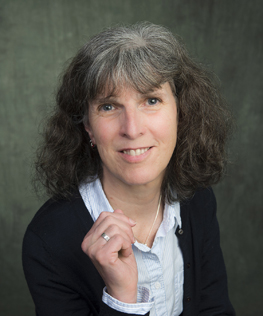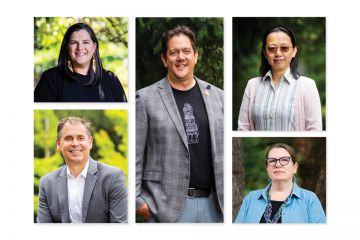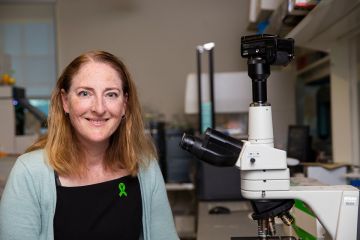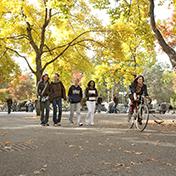Susan Boyd named to federal marijuana task force
- Kate Hildebrandt
Decades of activism, followed by a seat at the table
When asked how she felt about her invitation to volunteer on the federal task force for legalizing marijuana announced by the Government of Canada on June 30, 2016, Dr. Susan Boyd, a UVic distinguished professor with the Faculty of Human and Social Development (HSD), replied, “I am really pleased we are doing this. I just wish it could’ve happened in the 1970s.”

It's a fair sentiment coming from Boyd, who's devoted her education and academic career to research, teaching and community activism challenging conventions and laws on substance use—publishing seven books and 30 articles on the subject. Her writing explores marijuana growing and regulation; media representations; heroin-assisted treatment; women, pregnancy, and mothering; the history of drug prohibition and resistance; and harm reduction. For many years, Boyd was also a steering committee member for the Canadian Drug Policy Coalition. In HSD at UVic, she teaches research methodologies, social and cultural perspectives on drug issues, media representations of drug issues, women and drugs, and critical theory.
The invitation to join the task force “came out of the blue,” Boyd reflects. Surprised to be asked, “given the number of scholars, lawyers, and other experts they had to choose from,” she is certainly not unprepared. In addition to more than 25 years immersed in the subject and its impact on the human condition, she’s been closely, hopefully, following the prime minister’s electoral promise to create a legal framework for access to marijuana in Canada.
“The best model should cause the least harm.”
Harm reduction is a philosophy of care and compassion that has proven to yield better outcomes than criminalization. In fact, Boyd was on the forefront of this approach when, in 1991, she and colleagues Margaret Michaud and Olive Phillips created one of the first woman-centred, harm-reduction programs based in Vancouver’s downtown east side. Their grassroots program evolved from outreach and support to activism and advocacy for women deemed ‘too difficult to reach’, ‘non-compliant’, or ‘failures’ by drug treatment workers and other professionals.
“Our door was open to all women, especially pregnant women and mothers,” says Boyd. Providing an alternative to 12-step programs, they focused instead on harm reduction, stabilization and self-empowerment. Abstinence from drugs was not required. “Reunification of the family was a central component because most of the women in the program had at least one child apprehended by the state.”
Permanent child apprehension was the norm at the time, Boyd explains, as it was believed drug-dependent mothers were incapable of parenting. Her research showed time and again how harm reduction practices using compassionate care led to far more successful outcomes.
As for what this historic federal initiative could achieve, she said, “I would like to see the most inclusive framework we can come up with. The best model should cause the least harm.”
Given Boyd’s anti-prohibitionist perspective, she is curious to see just how inclusive Canada’s new model can be. “It’s not about whether or not this legal model will be created, but what it will look like.”
A tight timeline for change
The task force has three months to develop a proposed model. They met for the first time in mid-July for two days and are required to deliver their recommendations by November 2016. A model is to be in place by spring 2017.
“It is rather ambitious,” she says, given the procedural parameters of their task to not only develop a report recommending a model, but to also share the plan with ministers, the Senate, and parliament. Even so, Boyd says, “The role of this task force is actually quite narrow. The heavy-lifting will be done by the three ministries—Justice, Health and Public Safety—who have created the website content, the discussion paper, the questions, the process, and they will do the analyzing. From that, the task force will write a report and propose a preferred model.”
The task force will also connect with other researchers and study their key findings, however, their key role is “to listen to what Canadians have to say on the legal model they want to see.”
This raises questions as Canada’s marijuana culture is normalized yet remains criminalized, Boyd says. “I’m sure we will hear a great deal about the harm of criminalization.” The harm caused by consuming drugs is well studied and understood, she adds, yet the harm of criminalization is not. “People who have been arrested for using marijuana live with criminal records. Their career and travel options may be limited. There may be trauma and discrimination related to their contact with criminal justice and imprisonment.”
These and other large questions must be addressed, she adds.
“We don’t really know about potential profits from legalizing marijuana, or the illegal market’s take.” Growers come in all sizes, from small to corporate farms. Lessons can be learned from the American experience: marijuana is legal in Colorado, Oregon, Alaska, and Washington. Uruguay stopped penalizing possession of marijuana for personal use in 2014, and the pioneering Netherlands’ coffee shop dispensaries followed a 1976 law for low possession.
Unsure of what Canada’s legal framework might look like in the end, Boyd says she can only speak to what she knows best which is the BC marijuana culture and the impact of criminalization. She notes that Canada has adopted harm reduction as a national drug strategy although this has not been realized in practice partially due to resistance by national law enforcement groups and adherents of abstinence-based only programs.
“In many ways, drug scares and moral panics about drug use and drug prohibition continue to shape harm-reduction research, policy, education and practice,” she explains, adding there are other complexities around drug use that are not fully understood.
“An individual researcher, such as myself, cannot achieve what this task force is mandated to do, or what this government can do in relation to setting up a process to hearing from many Canadians on the model of legalization they prefer,” says Boyd. “The final report may not conclude the same findings, say, as with my own research so this is all very interesting to me.”
For more information about the task force and its next steps, visit the federal government’s website. (Government of Canada news release here, with links to other relevant information.)
In this story
Keywords: health, marijuana, drugs, law, addiction, government, research
People: Susan Boyd




